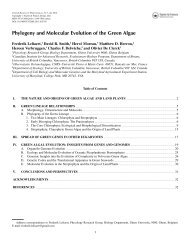Phylogeny and molecular evolution of green algae - Phycology ...
Phylogeny and molecular evolution of green algae - Phycology ...
Phylogeny and molecular evolution of green algae - Phycology ...
You also want an ePaper? Increase the reach of your titles
YUMPU automatically turns print PDFs into web optimized ePapers that Google loves.
44 CHAPTER 3<br />
Background<br />
Elongation factor-1 alpha (EF-1α) is a core element <strong>of</strong> the translation apparatus <strong>and</strong> member <strong>of</strong> the<br />
GTPase protein family. The gene has been widely used as a phylogenetic marker in eukaryotes; either<br />
to resolve their early <strong>evolution</strong> (e.g., Baldauf et al. 1996, Roger et al. 1999) or more recent<br />
phylogenetic patterns (e.g., Hashimoto et al. 1994, Baldauf <strong>and</strong> Doolittle 1997, Beltran et al. 2007,<br />
Sung et al. 2007, Zhang <strong>and</strong> Qiao 2007). The <strong>evolution</strong>ary history <strong>of</strong> genes used for such inferences<br />
should closely match that <strong>of</strong> the organisms <strong>and</strong> not be affected by ancient paralogy or lateral gene<br />
transfer (Keeling <strong>and</strong> Inagaki 2004). A gene related to but clearly distinguishable from EF-1α, called<br />
elongation factor-like (EFL), appears to substitute EF-1α in a scattered pattern: several unrelated<br />
eukaryote lineages have representatives that encode EFL <strong>and</strong> others that possess EF-1α. The EFL <strong>and</strong><br />
EF-1α genes are mutually exclusive in all but two organisms: the zygomycete fungus Basidiobolus <strong>and</strong><br />
the diatom Thalassiosira (James et al. 2006, Kamikawa et al. 2008). Although EFL is found in several<br />
eukaryotic lineages, EF-1α is thought to be the most abundant <strong>of</strong> both (Rogers et al. 2007). So far,<br />
EFL has been reported in chromalveolates (Perkinsus, din<strong>of</strong>lagellates, diatoms, haptophytes,<br />
cryptophytes), the plant lineage (<strong>green</strong> <strong>and</strong> red <strong>algae</strong>), rhizarians (cercozoans, foraminifera), unikonts<br />
(some Fungi <strong>and</strong> choanozoans) <strong>and</strong> centrohelids (Keeling <strong>and</strong> Inagaki 2004, Gile et al. 2006, Noble et<br />
al. 2007, Kamikawa et al. 2008, Sakaguchi et al. 2008).<br />
The mutually exclusive distribution <strong>of</strong> EF-1α <strong>and</strong> EFL suggests similar functionality. The main function<br />
<strong>of</strong> EF-1α is translation initiation <strong>and</strong> termination, by delivering aminoacyl tRNAs to the ribosomes<br />
(Negrutskii <strong>and</strong> El'skaya 1998). Other functions include interactions with cytoskeletal proteins:<br />
transfer, immobilization <strong>and</strong> translation <strong>of</strong> mRNA <strong>and</strong> involvement in the ubiquitine-dependent<br />
proteolytic system, as such forming an intriguing link between protein synthesis <strong>and</strong> degradation<br />
(Negrutskii <strong>and</strong> El'skaya 1998). In contrast, the function <strong>of</strong> EFL is barely known. It is assumed to have<br />
a translational function because the putative EF-1β, aa-tRNA, <strong>and</strong> GTP/GDP binding sites do not differ<br />
between EF-1α <strong>and</strong> EFL (Keeling <strong>and</strong> Inagaki 2004). Based on a reverse transcriptase quantitative PCR<br />
assay in the diatom Thalassiosira, which possesses both genes, it was proposed that EFL had a<br />
translation function while EF-1α performed the auxiliary functions (Kamikawa et al. 2008).<br />
The apparently scattered distribution <strong>of</strong> EFL across eukaryotes raises questions about the gain-loss<br />
patterns <strong>of</strong> genes with an important role in the cell. This mutually exclusive <strong>and</strong> seemingly scattered<br />
distribution can be explained by two different mechanisms: ancient paralogy <strong>and</strong> lateral gene<br />
transfer. Ancient paralogy was considered unlikely because this would imply that both genes were<br />
present in ancestral eukaryotic genomes during extended periods <strong>of</strong> <strong>evolution</strong>ary history while the<br />
genes rarely coexist in extant species (Keeling <strong>and</strong> Inagaki 2004). Furthermore, a prolonged<br />
coexistence <strong>of</strong> both genes in early eukaryotes would have likely resulted in either functional<br />
divergence or pseudogene formation <strong>of</strong> one or the other copy (Van de Peer et al. 2001), as is<br />
suggested for EFL <strong>and</strong> EF-1α coexisting in the diatom Thalassiosira (Kamikawa et al. 2008). Keeling<br />
<strong>and</strong> Inagaki (Keeling <strong>and</strong> Inagaki 2004) proposed lateral gene transfer <strong>of</strong> the EFL gene between<br />
eukaryotic lineages as the most likely explanation for the scattered distribution <strong>of</strong> both genes.<br />
In the <strong>green</strong> plants (Viridiplantae), EF-1α <strong>and</strong> EFL seem to show a mutually exclusive distribution. Of<br />
the two major <strong>green</strong> plant lineages, the Chlorophyta were shown to have EFL with the exception <strong>of</strong><br />
Acetabularia where EF-1α is found, <strong>and</strong> the Streptophyta were shown to possess EF-1α with the

















